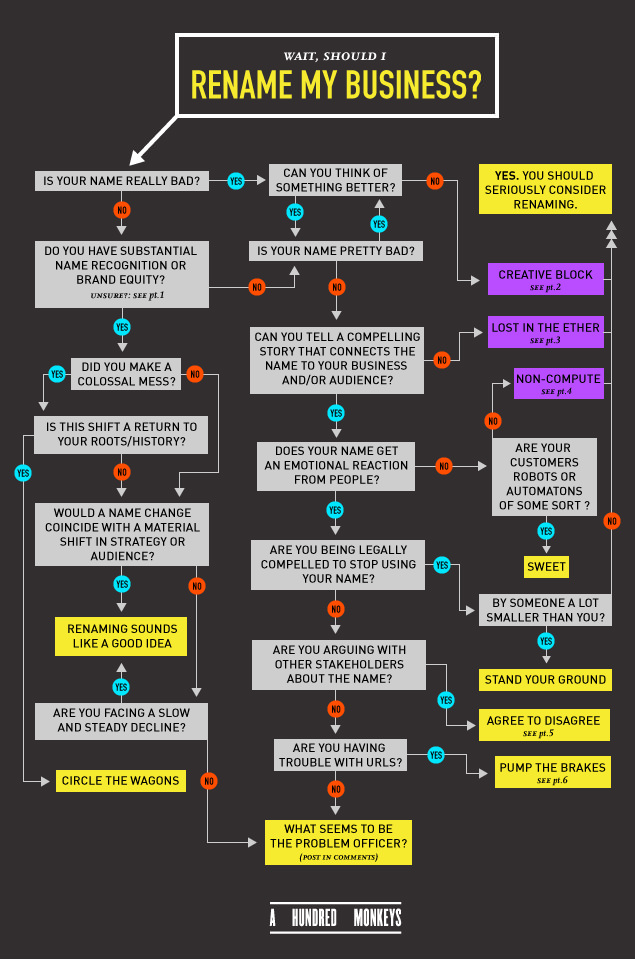Should you rename your business? Check our flow chart
Deciding to rename your business is a pretty big decision. Do you have too much brand equity? Too many stakeholders? Does your name connect with your audience? Can it? So we created this flow chart to help you sort through the key issues in renaming a business. If you run into any snags, we’re here to help.
Pt. 1: Do you have substantial name recognition or brand equity? It would be great if there was a viable metric for brand equity but alas, there is not. The big question here is if you have a critical mass of (probably old school) users or clients who would take serious issue with renaming. Now, some people are going to be upset. This is what people do when things change. You need to differentiate between the potential for minor discomfort, and the potential for upheaval.
When you rename you shouldn’t treat it like a big reveal when you yank down the curtain and proclaim ‘We will henceforth be called … Action Jackson!” No. Bad idea. You should treat a rename like a transition. Confidently let people know what you’re doing and why you’re doing it. Don’t open the floor for conversation but let them reach an understanding of why you’re making the change and what it will (or won’t) mean for them.
Pt. 2: Creative block. So, you can’t think of a good name. It happens. Reading about all the different species of names might help. You could also hire a naming company. The biggest benefit of hiring a naming company other than the naming, is that you don’t have to spend any more time thinking about it. The weight is off your shoulders. You can go back to spending your time on the stuff you’re good at while naming gets the attention it deserves.
Pt. 3: Lost in the ether. So you have a name that sounds cool but has no meaningful connection to your business or audience. These names are what we like to call “empty vessels.” They’re called that because while they might look nice in your foyer, unless you have a massive marketing budget to jackhammer the word into people’s brains, they don’t do much for you. A name can only be great if you can connect it to what you’re doing in a meaningful way. Otherwise you just have a word people are going to have a hard time spelling and remembering.
Pt. 4: Non-compute. It would be a lot easier if your customers were robots. Although, I’m not sure how prevalent consumerism is amongst Predator drones. With people however, names should get a response. They should make someone smile or laugh or ask a question. This reaction is what leads to memorability and the decision on their part to actually pay attention to you. Without an emotional reaction a name is most likely in one ear and out the other. The brand I like to pick on here is AirTran airlines. They do transportation. In the air. Fascinating.

Pt. 5: Agree to disagree. In practice, naming is about 20% creativity and 80% getting people to agree on something. The only problem is creative work shouldn’t be about agreement. It should be about coming up with something cool and interesting. We call this the Ice Cream Paradox: send 10 people for ice cream but tell them they have to agree on one flavor. It’s going to be chocolate or vanilla. Every time. In the context of naming this means a boring name that sounds like everyone else’s. Working with a naming company makes this problem evaporate. With someone on the outside taking control of the process, the focus can be on the best work instead of balancing the feelings of your coworkers.
Pt. 6: Pump the brakes. A lot of people prioritize URLs unnecessarily. It really depends on the specifics of your situation. That’s why we wrote a whole treatise on URLs. You might be in better shape than you think.
You made it to the end–good work. Now would be an opportune time to take a look at our approach to naming.

